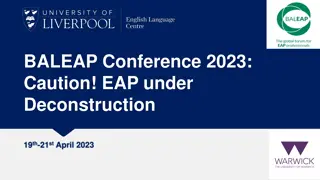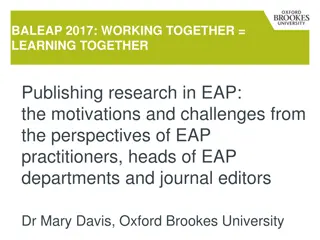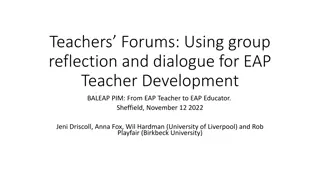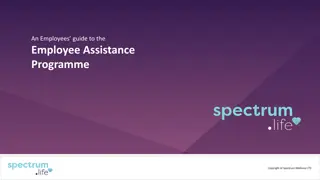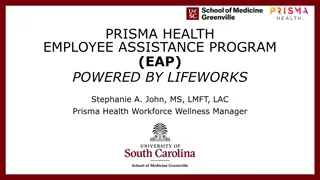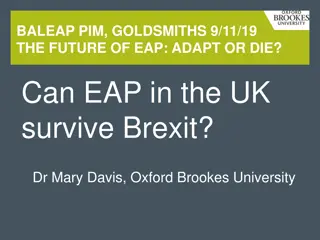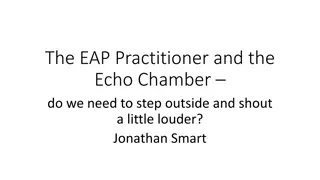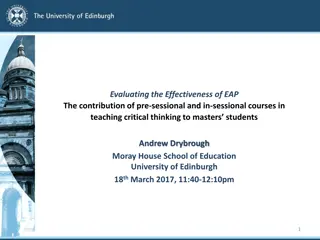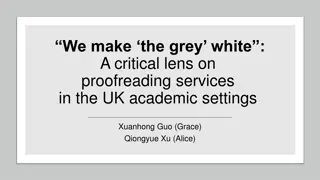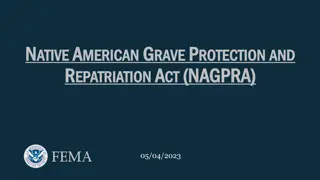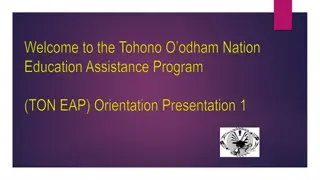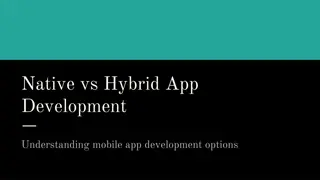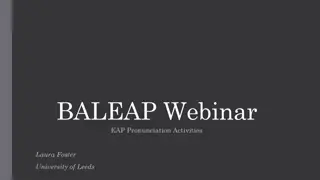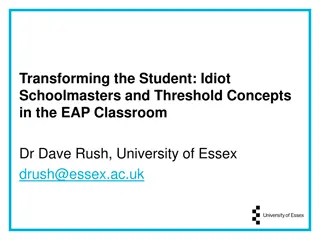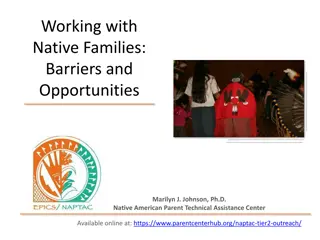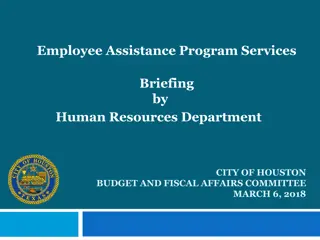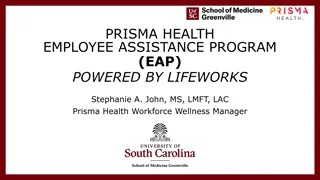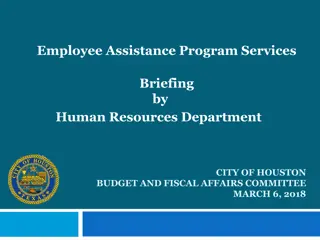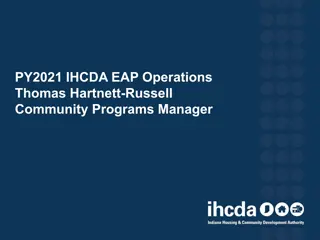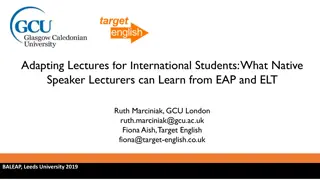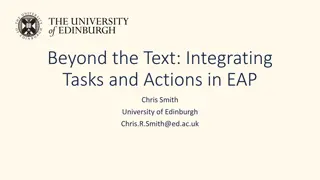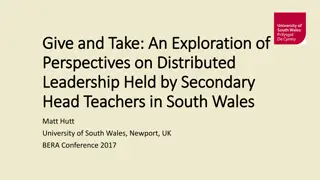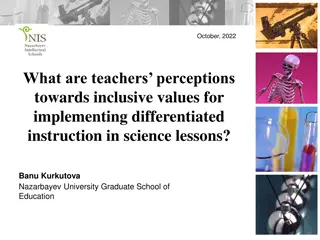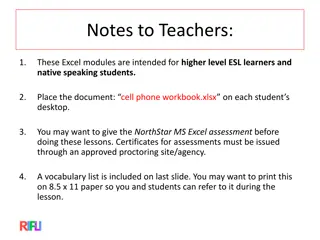Exploring the Role of Non-Native Teachers in EAP in the UK
This study delves into the identities, advantages, and challenges faced by non-native English teachers in English for Academic Purposes (EAP) in the UK. By examining the nuanced aspects of non-native identities, accent perceptions, and societal expectations, the research sheds light on the complexities and experiences of these educators.
Download Presentation

Please find below an Image/Link to download the presentation.
The content on the website is provided AS IS for your information and personal use only. It may not be sold, licensed, or shared on other websites without obtaining consent from the author. Download presentation by click this link. If you encounter any issues during the download, it is possible that the publisher has removed the file from their server.
E N D
Presentation Transcript
Exploring the role of non-native teachers in English for Academic Purposes (EAP) in the UK Kaz Yamamoto ky14506@bristol.ac.uk Julia Gardos julia.gardos@bristol.ac.uk
Outline Non-native identity & our experience Advantages of non-native tutors Research & findings
Intro Who is a native speaker? - Define - Problematic: dichotomy or scale (Llurda 2009) Krashen: acquisition vs learning (1981) distinction useful to explore advantages of both groups
Kazs background Learnt English & French as a kid Lived in the US, Canada and France as an adult
Julias background Born in Hungary, first moved to England aged 7 for 3 years Back in the UK since 2007
Appearance and accent Generation 1.5 Born outside Canada and US or born to immigrant parents, but received most of their secondary and/or elementary education in North America (Faez 2012) Ss evaluate Ts by their accent & ethnicity (Lindemann 2002, Rubin 1992) Ts fear not being accepted as native due to their racial identity
Accent Accent Idiolect Sociolect Dialect World Englishes Louwerse (2004) Kachru (1997)
Identity Native speaker fallacy deficit view (Phillipson, 1992) Identity problems: pathology discourse (Richardson, 2016) Inferiority complex (Medgyes, 1994) I m not a NS syndrome (Suarez, 2000) Stockholm syndrome (Llurda, 2009) Impostor syndrome (Bernat, 2008)
Identity Impostor in the writing centre Trials of a Non-native tutor (Wahlstrom, 2013) Language use: hide, conceal, allows me to pass, at the very least be a NS,should the truth surface Appearance, accent Student expectations both foreign and home What is your experience?
NEST vs Non NEST Differences in EFL Non NESTs can; serve as imitable models of the successful learner of English. teach learning strategies effectively. provide learners with information about the English language. anticipate language difficulties. have empathy towards students. benefit from sharing the learners mother tongue. Medgyes (1992)
Non-native teachers in EAP 1) Non-native teachers more empathetic? Panayotova (2016) transition from result-oriented learning to process-oriented learning critical thinking rationale for pair work / group work independent learner training
Non-native teachers in EAP Academic language is nobody s mother tongue (Bourdieu, 1994) Native speaker also 2nd language learner Easier for NS to learn academic language? (Jenkins, 2016) EAP: teaching language AND academic culture Non-natives as model learners on several levels
Our experience at UoB KAZ: - Understanding students academic challenges - Sharing cultures JULIA: - In-sessional EAP support for international graduate students sharing own experience - Model for Ss in learning new academic culture
Our research Research gap: non-native teachers in EAP Context: Pre-sessional summer course at UoB, majority of Ss Chinese Based Walkinshaw & Hoang Duang (2012) 72 PS (out of 920) students rated 8 factors of a good PS teacher Avoiding bias
Our research 8 important factors of being a good teacher Enthusiasm for teaching Can you guess: Top factor Bottom factor Where the native speaker ranked 1=most important 8=least important Friendly personality Native speaker of English Delivers interesting / informative classes Familiar with local culture Appropriate qualifications Teaching experience Linguistic fluency
Results Participants: 72 Pre-sessional students Modes Results 1 Enthusiasm for teaching 1. 2. 3. 4. 5. 6. 7. 8. Enthusiasm for teaching Friendly personality Delivers interesting / informative classes Teaching experience Linguistic fluency Appropriate qualifications Native speaker of English Familiar with local culture 8 Native speaker of English/Familiar with local culture The number of participants who chose Native speaker of English Most important factor: 3 participants (4.2%) Least important factor: 30 participants (41.7%)
Thematic analysis of students comments Native speaker of English Pronunciation Language fluency Enthusiasm for teaching Lively/enjoyable Interesting Patience Passion Preparation (well prepared)
A message from Peter Medgyes My message for Bristol University is very simple: native and non-native teachers are different but serve an equally useful purpose. The best way to move forward is to have both kinds of animals who work in close collaboration with each other - and love each other too. Simple, isn't it?
University of Bristol Supportive towards non-native tutors PS course - diversity of tutors - pairings Summer 2016: CPD session Blog post webinar Leading to conference
Collaboration How can native and non-native EAP tutors collaborate effectively?
References I Bernat, E. 2008. Towards a pedagogy of empowerment: The case of impostor syndrome among pre-service non-native speaker teachers in TESOL. ELTED, vol. 11 Bourdieu, P. and Passeron, J.-C. 1994. Introduction: Language and the relationship to language in the teaching situation. In P. Bourdieu, J.-C. Passeron & M. de Saint Martin, Academic discourse (pp. 1-34). Cambridge: Polity Press Canagarajah, A.S. (1999) Interrogating the Native speaker fallacy : Non-linguistic roots, Non-pedagogical results. In G. Braine (ed.) Non-Native Educators in English Language Teaching (pp. 77 92). Mahwah, NJ: Lawrence Erlbaum. Cheung, Y. L. (2002). The attitude of university students in Hong Kong towards native and non-native teachers of English. Chiba, R., Matsuura, H., & Yamamoto, A. (1995). Japanese attitudes toward English accents. World Englishes,14(1), 77-86. English-speaking teaching assistants. Research in Higher Education, 33, 511-531. Faez, F. (2012). Linguistic identities and experiences of generation 1.5 teacher candidates: Race matters. TESL Canada Journal, 29, 124. Jenkins, J. 2016. Closing remarks. BALEAP PIM EMI in Higher Education: the challenges and the opportunities. University of Southampton. Kachru, B. B. (1997). World Englishes and English-Using Communities. Annual Review of Applied Linguistics, 17, pp 66-87. Kramsch, C. (1997). Guest column: The privilege of the nonnative speaker. Publications of the Modern language Association of America, 359- 369. Krashen, SD. 1981. Second Language Acquisition and Second Language Learning. Pergamon Press. Lindemann, S. (2002). Listening with an attitude: A model of native-speaker comprehension of non-native speakers in the United States. Language in Society, 31, 419-441. Lippi-Green, R. (1997). English with an accent: Language, ideology, and discrimination in the United States. Psychology Press. Llurda, E. 2009. The decline and fall of the native speaker. In L. Wei & V. Cook (Eds.) Contemporary Applied Linguistics: Language Teaching and Learning. Louwerse, M. M. (2004). Semantic variation in idiolect and sociolect: Corpus linguistic evidence from literary texts. Department of Psychology / Institute for Intelligent Systems The University of Memphis.
References II Medgyes, P. (1992). Native or non-native: who s worth more? ELT Journal, 46(4), 340 349. Medgyes, P. 1994. When the teacher is a non-native speaker. In M. Celce-Murcia (Ed.),Teaching English as a second or foreign language, Third edition (pp. 415-428). Boston: Heinle & Heinle. Native English-speaking teachers: always the right choice? | British Council. (n.d.). Retrieved 27 March 2016, from https://www.britishcouncil.org/voices-magazine/native-english-speaking-teachers-always-right-choice Pacek, D. (2005). Personality Not Nationality : Foreign Students Perceptions of a Non-Native Speaker Lecturer of English at a University. In Non-native language teachers (pp. 243-262). Springer US. Panayotova, D. 2016. Non-native teacher contributions to EAP practice. BALEAP PIM EMI in Higher Education: the challenges and the opportunities. University of Southampton. Parekh, M. (2012, April 10). India s teachers face native-only bar. Retrieved 15 May 2016, from http://www.theguardian.com/education/2012/apr/10/india-teacher-prejudice-employment-bar Phillipson, R. (1992). ELT: The native speaker s burden. ELT Journal, 46(1), 13-18. Richardson, S. 2016. The native factor , the haves and the have-nots. IATEFL, Birmingham. https://iatefl.britishcouncil.org/2016/session/plenary-silvana-richardson Rubin, D.L. (1992). Nonlanguage factors affecting undergraduates judgments of non-native English-speaking teaching assistants. Research in Higher Education, 33, 511-531. Suarez, J. 2000. NATIVE AND NON-NATIVE : not only a question of terminology. Humanising Language Teaching Year 2; Issue 6. Wahlstrom, H, 2013. Impostor in the Writing Center Trials of a Non-Native Tutor. The Writing Lab Newsletter, Volume 38 3-4, pp. 10-13. Walkinshaw, I., & Duong, O. T. H. 2012. Native- and Non-Native Speaking English Teachers in Vietnam: Weighing the Benefits. TESL-EJ, 16(3), 1 17. British




